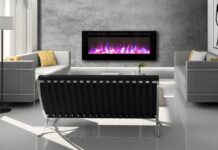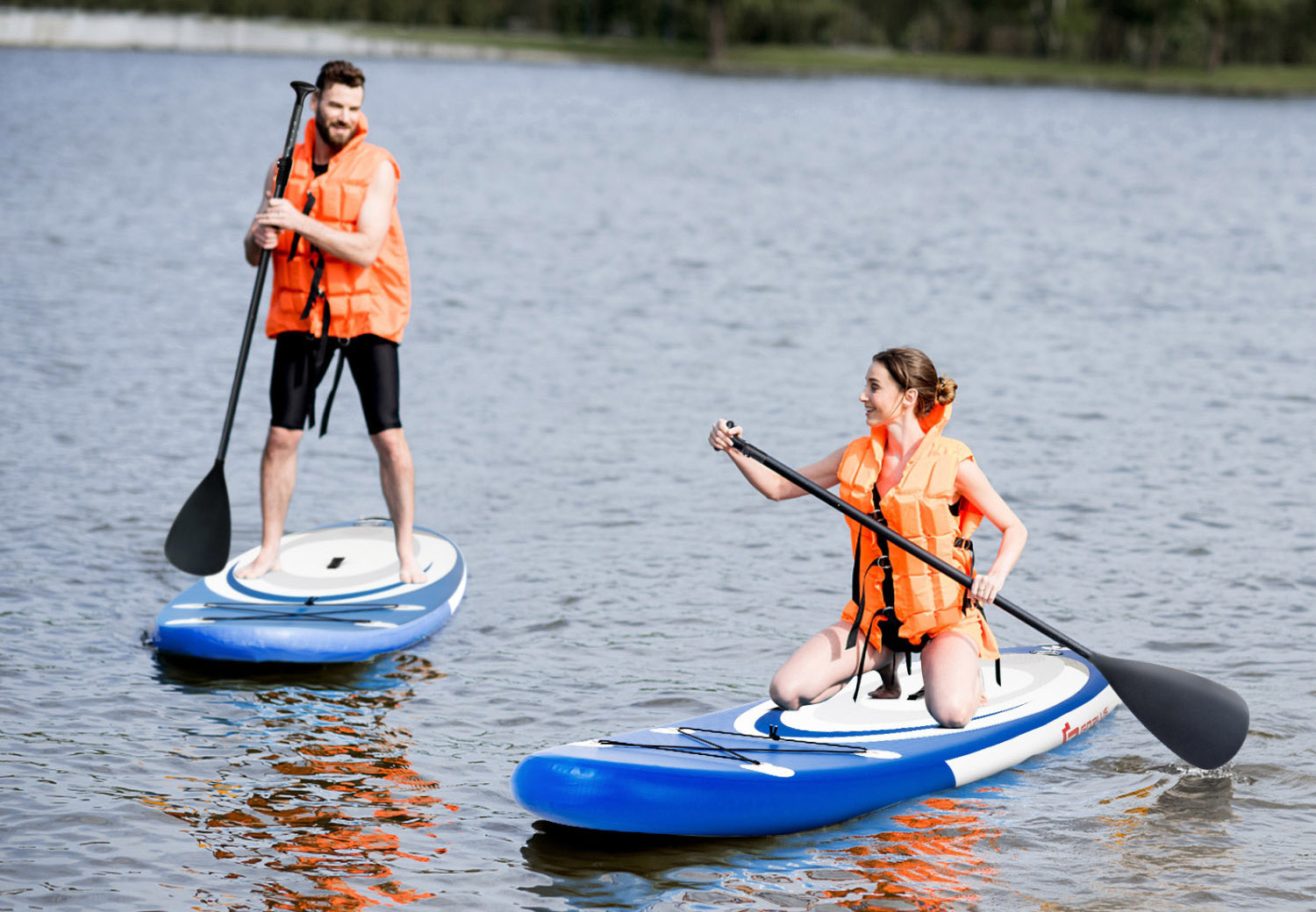
If you love water sports, you’re likely already familiar with paddle boarding and may be considering buying a paddle board this year. This sport traces back to 3000 B.C., and may originate from South America, Africa, or Polynesia. For many communities who lived on the water, paddle boarding was an essential part of life. In fact, Native Hawaiians used to use wooden paddle boards to travel from island to island, which likely inspired today’s stand-up paddle boarding. Modern paddle boarding started to gain traction in the 1980s, and has exploded in popularity since the start of the 2000s.
Today’s paddle boards are often made from materials like epoxy and fibreglass rather than wood, and paddle boarding has branched into two disciplines: traditional kneeling paddle boarding and stand-up paddle boarding.
The most common type of paddle boarding right now is stand-up paddle boarding, which may be shortened to SUP or SUP boarding. SUP boarding offers a fun way for the whole family to stay active while taking in amazing views, making it a popular alternative to kayaking. It offers an excellent cardiovascular and core workout, but has a low barrier of entry, which means people of all ages and fitness levels can enjoy it. Avid paddle boarders often take their pets out on the water with them, and there are even activities that have been modified to take place on top of boards, such as SUP yoga and fishing.
To explore these exciting SUP boarding activities, choosing the right paddle board for your adventures, selecting a right size SUP, and maintenance tips for your paddle boards, dive into our ultimate guide to buying a paddle board.
- What is a paddle board?
- Types of paddle boards
- Selecting the right size of paddle board
- Inflatable vs epoxy paddle boards
- How to inflate and deflate a paddle board
- How to store and care for your paddle board
What is a paddle board?
While paddle boards and surfboards have a few things in common, the two sports are quite different. Paddle boards are larger and thicker than surfboards, with a more generous frame that’s designed to be used on calmer waters. Surfers do paddle out to the waves on their boards, but surfing is about catching and riding waves—so surfboards are thinner, sharper, and more responsive than paddle boards.
Paddle boards are designed to lift the rider out of the water in any scenario, and don’t require the same amount of responsiveness and customization as surfboards. As a result, they’re chunkier and more voluminous, with more gently curved ends. This design makes them very buoyant, so they’re easy to balance and direct with just a little practice.
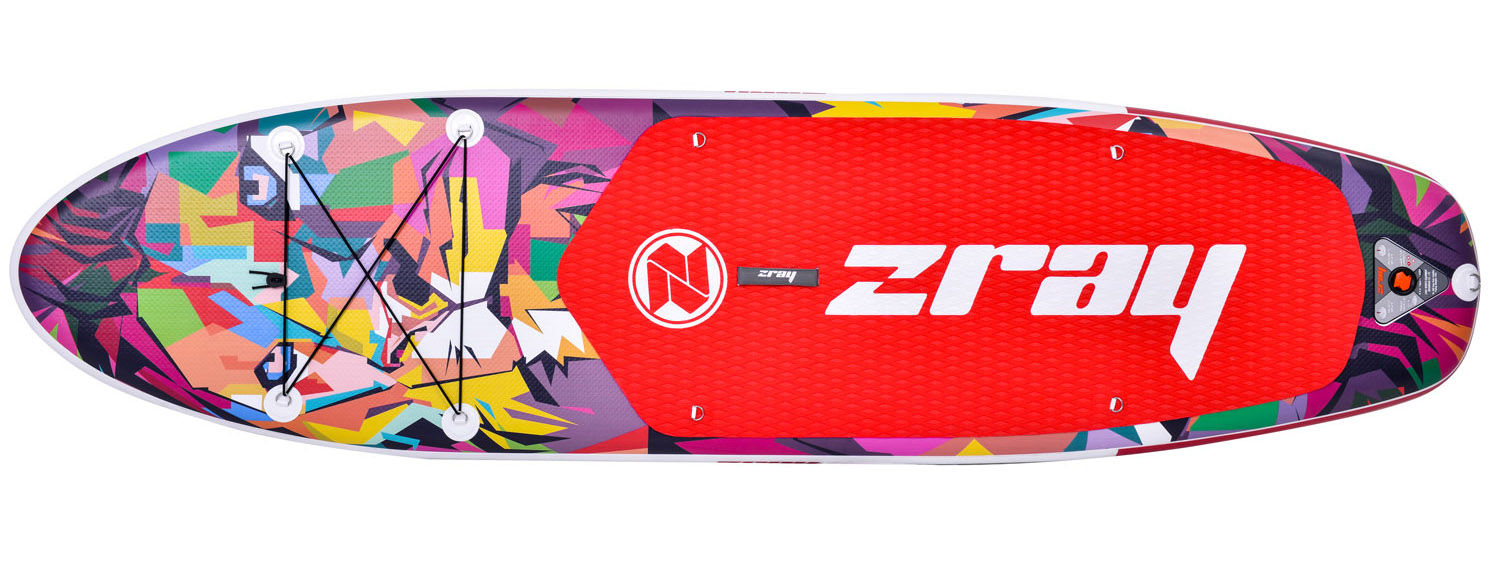
The basic build of a paddle board consists of a nose (front end), tail (rear end), side rails, and centre handle, with a leash ring at the tail and 1-3 detachable fins on the underside of the board to provide control and direction in calm waters. The leash is meant to keep your paddle board with you even if you tumble off, and the board is intended to be used with a long, separate paddle.
If you’ve never tried or seen paddle boarding before, you may be surprised by the size of these boards. Stand-up paddle boards are generally around 11 feet tall, making them taller than the average height of a room. Thankfully, there are plenty of inflatable paddle board options available that keep these boards convenient to store and transport.
Types of paddle boards
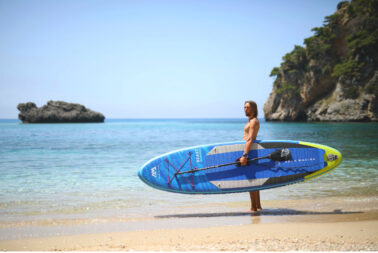
The shape of your ideal paddle board depends on how you plan to use it. Different shapes of paddle boards are specialized to help you explore different facets of the sport, such as surf paddle boarding, racing paddle boarding, and whitewater paddle boarding. Expert paddle boarders can use any type of board for any of the different types of boarding, but selecting one that’s purpose-made will make it easier to use and enjoy.
All-around paddle boards
In general, an all-around paddle board for stand-up paddle boarding will be of middling width and length, with plenty of space to balance on and two gently rounded ends. These are best for paddle boarders who aren’t quite sure what they’re looking for, or who plan to try out lots of different types of paddle boarding. If you don’t plan on specializing into a specific type of paddle boarding, then an all-around SUP is right for you.
Touring paddle boards
Touring paddle boards are long and narrow. They’re very similar to all-around SUPs, but have a pointed nose instead of a rounded one. This makes them better for paddling over choppy waters, and helps borders maintain speed over long distances.
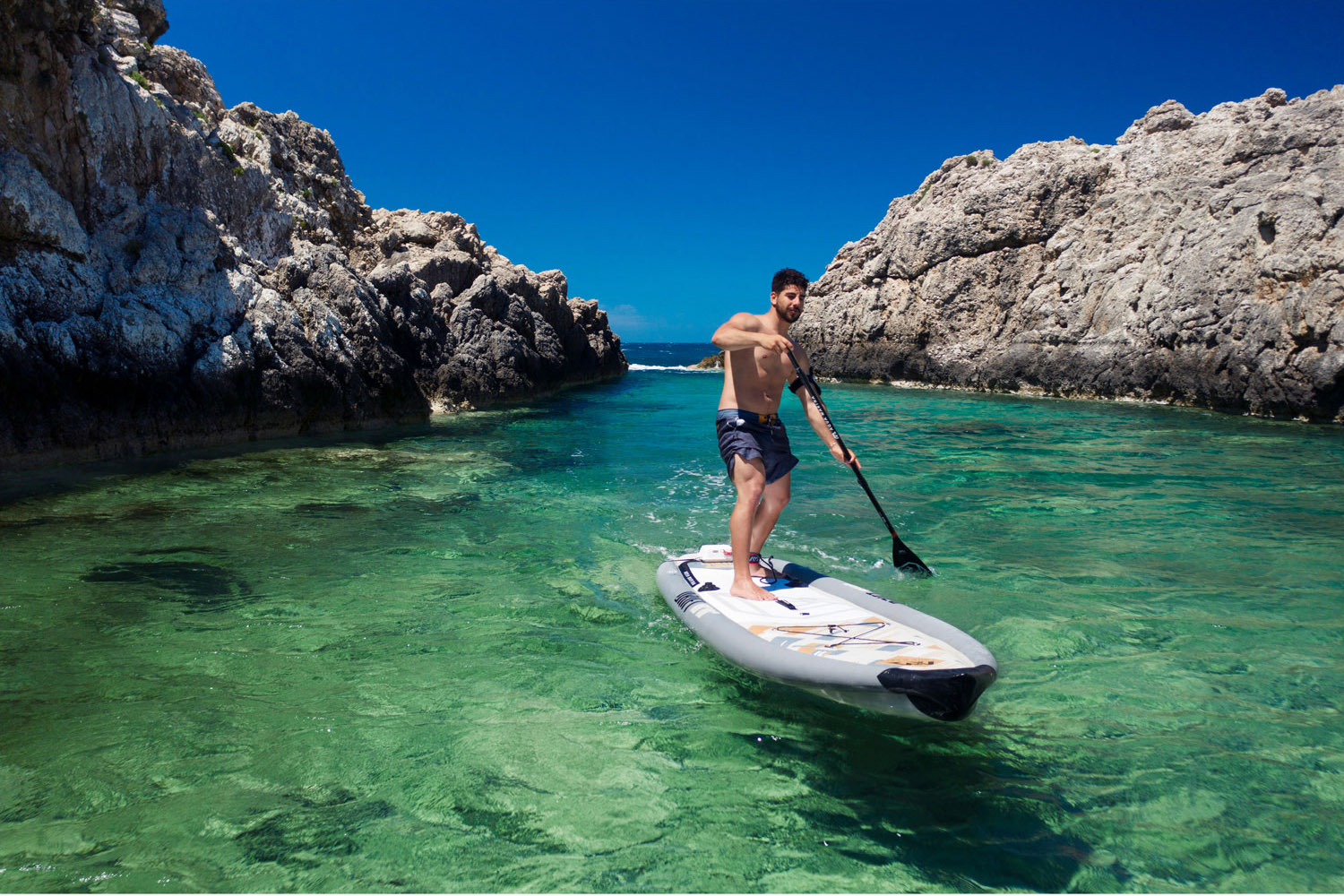
Racing paddle boards
Racing paddle boards for paddle boarding experts are very long and narrow, with a pointed nose. Paddle board races are divided by board length, but the most popular length for a racing paddle board is 14 feet. Where most SUPs are inflatable, most racing models are hard boards, designed to be smooth and responsive rather than convenient.
Surfing paddle boards
Surfing paddle boards are short and narrow compared to other SUP boards. Generally under 9 feet in length, they’re also thinner than other stand-up paddle boards, at as few as 4″ thick. Their shorter length and thinner design makes them more suited for turning to catch or ride a wave.
Whitewater paddle boards
Whitewater paddle boards are popular here in Canada, with our many gorgeous white water rafting areas throughout the country. They tend to be on the wider side with a short or average length, which is ideal for smoothing out the more tumultuous whitewater current in this dynamic, challenging sport. Look for a rocker, or upturned nose, on your whitewater stand-up paddle board.
Fishing paddle boards
Finally, fishing paddle boards are wide and of average length. These boards come to a gentle point at their nose, but most importantly, offer an overwhelming number of accessory options compared to other types of paddle boards. Fishing SUPs may include fishing rod and camera mounts, removable fins, fishing racks, on-board coolers, and more.
Selecting the right size of SUP
Selecting the right size of SUP or kneeling paddle board is surprisingly easy. Unlike other outdoor sports equipment like surfboards or skis, paddle boards are very universal. They are generally sized by a maximum weight limit, with a length determined by intended use rather than the user’s height.
Paddle boards come with a listing of their maximum weight capacity, which is usually somewhere between 250-500 lbs. Some boards, often those designed for multi-purpose use, have a maximum weight that’s even higher than that, and can come close to 1000 lbs. For your first paddle board, it’s recommended to choose a board that’s at least 10’6″ long and can hold more than your weight.
Inflatable vs epoxy paddle boards
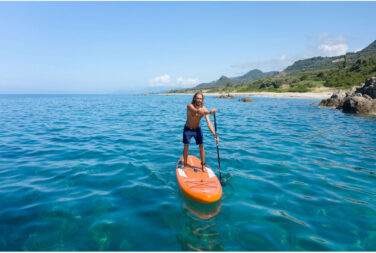
Firm paddle boards are built around a hard foam core made from polyurethane, expanded Styrofoam, or extruded polystyrene. This core, also called a “blank,” is shaped and sold as-is in cheaper beginner boards, which can be a great way for kids and newcomers to try out the sport.
In most cases, however, the foam blank is then covered and finished with durable layers of fibreglass, carbon fibre, or epoxy. This creates a beautiful finish that can be coloured and customized for the consumer and lasts longer over time. In finished epoxy paddle boards, you’ll find colourful designs, comfortable grooved footpads, and more, with an outer surface that does not have to be waxed as often as a surfboard to be maintained.
Another common type of paddle board is the inflatable paddle board. These are a popular choice for most paddle boarders, especially for SUP boarding, as they make these 10-11′ boards easier to transport and store. Inflatable paddle boards are designed to be lightweight, durable, and flexible, with soft, comfortable deck pads for standing on. You’ll find them made out of materials like military-grade drop-stitched fabric, multidirectional polyester, and reinforced PVC.
How to inflate your paddle board
Inflatable SUP boards typically come with a carrying case, paddle, leash, and high-pressure manual pump. If you’re purchasing an inflatable SUP, make sure to double check what comes in the box so you’ll be ready to go as soon as it arrives.
While you can hand pump any inflatable SUP, electric pumps are favoured for their convenience and simplicity. The faster method will depend on each person’s pumping speed, but in general, both manual pumping and electric pumping will take about 10 minutes.
Manual, or hand pumping, can be very convenient due to the light weight and small size of a manual pump. These are typically included with an inflatable paddle board and fit in your SUP’s carrying bag. With a hand pump, you can inflate your paddle board no matter where you are, and you never need to worry about finding a power source.
Electric SUP pumps, on the other hand, can be a great choice for inflating your board without the hassle and effort of a hand pump. They’re a popular choice for families with younger kids who can’t yet pump their own boards, or for older users who enjoy stand-up paddle boarding as a low-impact exercise. Electric pumps with a built-in PSI control are very convenient for inflating your paddle board to the right firmness with an auto-shutoff function, but because there is always a risk that the compressor may over-inflate your board by accident, using an electric pump can void the warranty on certain models of SUPs. Make sure to check this in your warranty information when you make your purchase.
Paddle boards typically require a PSI of 10-15 for recreational use, which will get your board firm enough for use without over-inflating it. You want your board to be firm enough that it doesn’t bend in the middle, but not firm enough to burst. Most electric pumps take about one minute to pump per PSI. So, if your board is ideally inflated to 14 PSI, an electric pump will take about 14 minutes to inflate it.
How to and when to deflate your paddle board
To deflate your paddle board, make sure you wash, rinse, and dry your board thoroughly first. Then, press down on your board’s valve stem and turn it as per your manual’s instructions. Usually, this is a quarter-turn clockwise. Your valve stem should lock into place and you should be able to hear the air rushing out of your paddle board.
If your paddle board is protected from the elements, it can be stored inflated for as long as you’d like. Over time, it will very slowly lose air pressure, so it will need to be reinflated before use. However, you do not need to deflate your paddle board after every use, and inflatable paddle boards are best stored partially inflated if you have the space to store them as such.
How to store and care for your paddle board
Epoxy paddle boards are best stored on a rack, off the ground. Outdoor storage racks may be available, but indoor storage will help protect your board from the elements and reduce wear and tear. The best way to store your paddle board is on a specially made SUP storage rack. If you’re using your board on a regular basis, it can be stored by spraying it down, drying it off, and storing it horizontally or vertically on a rack. Then, at the end of the season, it’s best to thoroughly wash, dry, and wax your paddle board before covering it and putting it on the rack for the winter.
Inflatable paddle boards store similarly, but with a few key differences. Wash, rinse, and dry your board after every use, then store to the best of your abilities. Inflatable paddle boards that are stored inflated and indoors last the longest, as this helps prevent any erosion, creasing, or warping in the board’s surface. If you don’t have the space for a paddle board storage rack, you can still store your board partially inflated indoors, which also helps to extend the life of your board. Make sure to reinflate your board fully with a manual or electric pump before every use.
Paddle board bags, which may come with your inflatable paddle board purchase, are convenient but are ideally used only for transport. If you need to store your board in its bag, make sure that it is completely clean and dry before it goes in, and roll it up as loosely as possible with its valve fully open. Store it lying down, whether inflated or deflated, so that the board is on its bottom and not on its sides. Paddle boards that are routinely stored in a bag may need to be replaced slightly more frequently, but the average inflatable SUP lasts for 5+ years with careful maintenance.
If you’re gearing up for thrilling water adventures, don’t stop at just acquiring a paddle board! At Best Buy, we understand your passion for exploration on the water. That’s why our selection of water sport accessories is designed to elevate your experiences from good to fantastic. Whether you’re in need of high-quality, durable paddle board bags for safe transport and storage, or you’re looking to enhance your adventure with waterproof action cameras, wearable GPS units, or stylish yet functional water-resistant attire, Best Buy has it all.
Take the next step
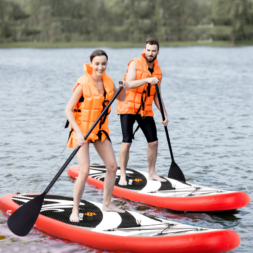
Paddle boarding is a fun way to stay fit with your family while enjoying beautiful scenery and breathtaking views. If you’re ready to coast on into paddle boarding season, check out paddle boards at Best Buy to explore your options.







